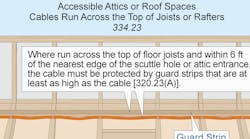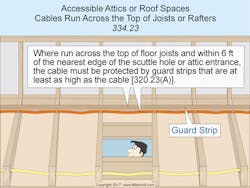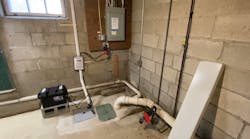All questions and answers are based on the 2017 NEC.
Q. What does the NEC require when Type NM cable is installed in accessible attics or roof spaces?
A. Type NM cable installed in accessible attics or roof spaces must comply with Sec. 320.23 [334.23] (see Figure).
In attics and roof spaces that are accessible, substantial guards must protect cables installed across the top of floor joists, or across the face of rafters or studding within 7 ft of the floor or floor joists. If this space isn’t accessible by permanent stairs or ladders, protection is required only within 6 ft of the nearest edge of the scuttle hole or attic entrance.
When Type NM cable is installed on the side of rafters, studs, or floor joists, no protection is required if the cable is installed and supported so the nearest outside surface of the cable or raceway is at least 1¼ in. from the nearest edge of the framing member if nails or screws are likely to penetrate [300.4(D)].
Q. What are the Code rules regarding the ampacity of conductors in Type NM cable?
A. Adjusted and corrected conductor ampacity for Type NM cable is based on the 90°C insulation rating per Table 310.15(B)(16); however, conductors are sized based on the 60°C termination temperature rating in accordance with Table 310.15(B)(16) [334.80].
Let’s run through an example calculation to further clarify this requirement.
Example: What size Type NM cable is required to supply a 9,600W, 240V, single-phase fixed space heater with a 3A blower motor?
Solution:
Step 1: Determine the load for the heater.
I = W ÷ E
I = 9,600VA ÷ 240V
I = 40A + 3A blower = 43A
Step 2: Size the conductors and overcurrent protection device at 125% of the total current load [110.14(C)(1) and 210.19(A)(1)]:
Conductor size = 43A × 1.25 = 53.75A
A 6 AWG, rated 55A at 60°C [Table 310.15(B)(16)]
Conductor/protection size = load × 1.25
Conductor/protection size = 43A × 1.25 = 53.75A
A 60A overcurrent protection device [240.6(A)]
If multiple Type NM cables pass through the same wood framing opening that’s to be sealed with thermal insulation, caulking, or sealing foam, the allowable ampacity of each conductor must be adjusted per Table 310.15(B)(3)(a).
This requirement has no effect on conductor sizing if you bundle no more than nine current-carrying 14 AWG or 12 AWG conductors together. For example, if three 14/2 cables and one 14/3 cable (eight current-carrying 14 THHN
conductors) are bundled together in a dry location, the ampacity for each conductor [25A at 90°C, Table 310.15(B)(16)] is adjusted by a 70% adjustment factor [Table 310.15(B)(3)(a)].
Adjusted conductor ampacity = 25A × 0.70 = 17.50A
Where more than two NM cables are installed in contact with thermal insulation without maintaining spacing between cables, the allowable ampacity of each conductor must be adjusted per Table 310.15(B)(3)(a).
Q. What is the NEC rule regarding the insulation temperature rating of the conductors in Type NM cable?
A. NM insulated conductors must be one of the types found in Table 310.104(A), and the insulation must be rated 90°C (194°F) [334.112].
Informational Note: Type NM cable identified by the markings NM-B meets this requirement.





